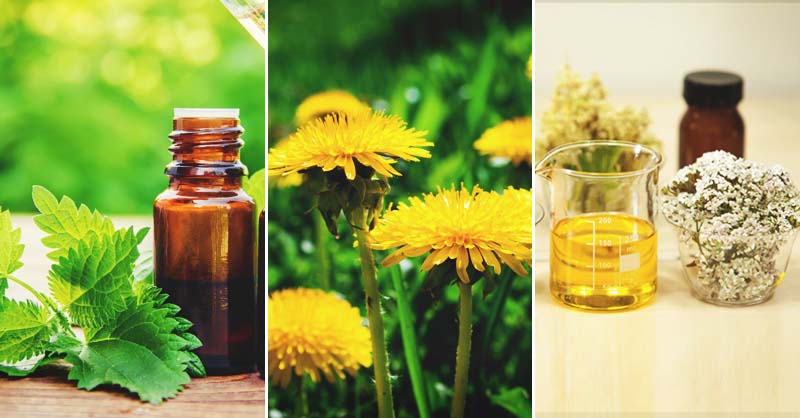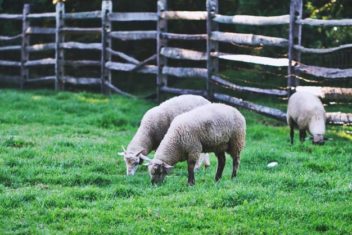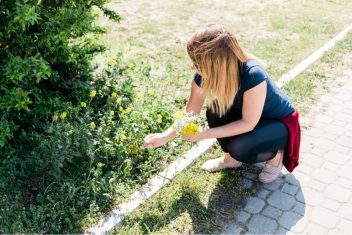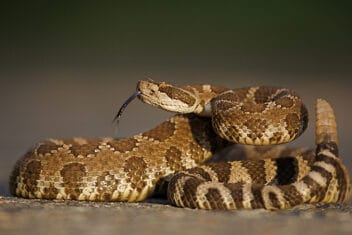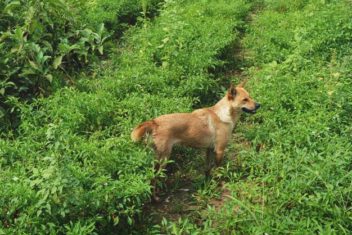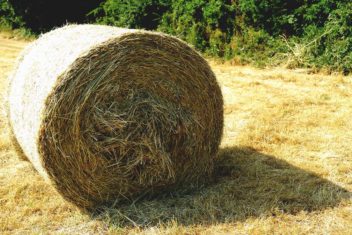What if I told you that the cure for your pesky cough or skin irritation was in your backyard right now? Or that medicine for your headache or heartburn could be growing wild by the roadside? Would you give the weeds that you try to combat with weed killer or yank from your garden beds another look?
Medicinal weeds are an underappreciated resource that could be growing in your backyard right now. In fact, I’d argue that these useful plants shouldn’t be referred to as pesky weeds at all. Below are 15 of the most common options out there, how you can use them, and what to watch out for.
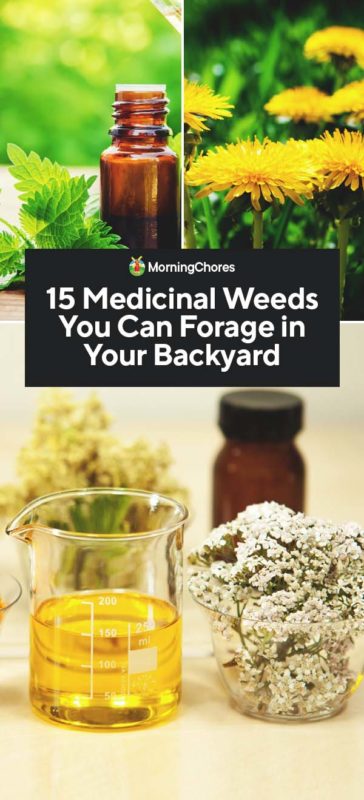
Medicinal Weeds
1. Dandelions (Taraxacum)
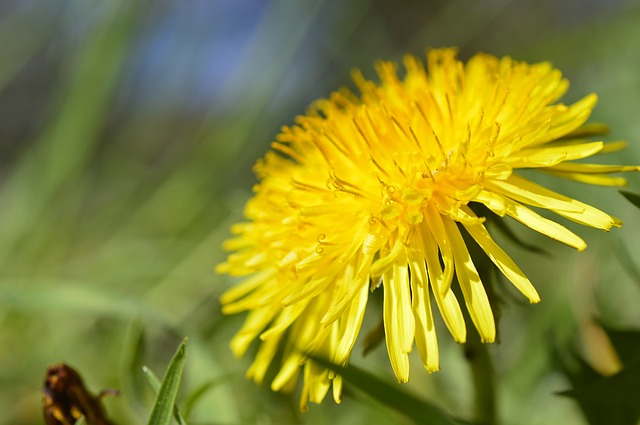
With all the fuss about dandelions these days, you might have clued into the excellent properties of this well-known weed. Dandelions go hand in hand with springtime, but you might not know that dandelions are full of vitamins A, B, C, and D.
You can use all the parts of this weed from the roots to the blossoms, and the entire plant is edible. The leaves are delicious in salads and soups. The roots are useful as an herbal tea or ground as coffee.
Dandelions have a history of treating liver problems and kidney disease, but that’s not the only uses for dandelions. You can also use dandelions for:
- Heartburn
- Appendicitis
- Diuretic
- Appetite stimulant
Watch out: Be careful when harvesting this plant to make sure you aren’t picking dandelions that have been poisoned.
Watch the video below to learn more about foraging dandelions (and violets).
2. Plantain (Plantago major)
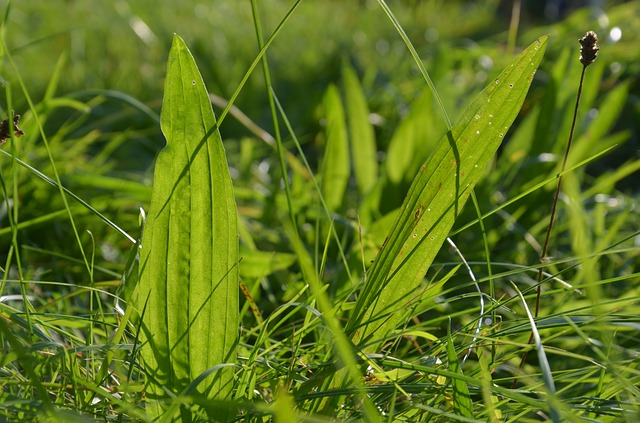
Plantain is one of the most common medicinal weeds out there. It never dies, or it feels like it never does, no matter how much weed killer you use on it. Plantain weed isn’t to be confused with the banana-like fruit that grows in the Caribbean.
You can eat plantain leaves raw or cooked, but you may want to choose the younger growth. Older leaves are tough and have an unpleasant taste, but you can still eat them if you wish.
Believe it or not, plantain has the same amount of vitamin A as a large carrot, and it’s high in vitamin B1 and riboflavin.
How can you use plantain medicinally? It can treat:
- Bronchitis
- Sore Throats
- Cold Symptoms
- Reduce Pain and Discomfort
- Stimulate Cellular Growth
- Regenerate Tissue
- Soothe Diarrhea
- Treat Fevers
Watch out: Like dandelion, lots of people poison plantain to try and get rid of it. Be sure the plants you are harvesting haven’t been sprayed.
3. Stinging Nettle (Urtica dioica)
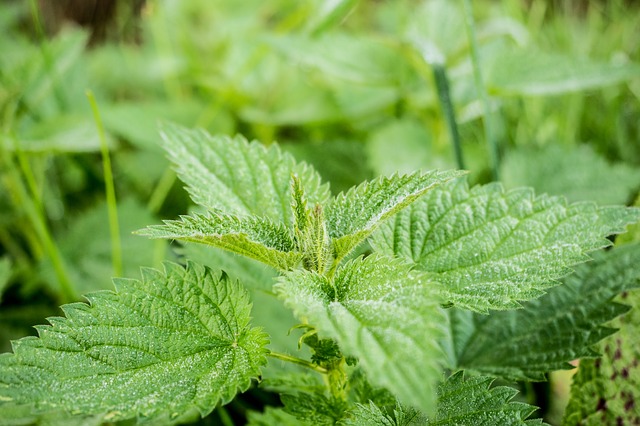
Have you ever made the mistake of grabbing stinging nettle with your hands? It’s not a fun thing. You need to wear gloves or have some seriously thick skin when picking stinging nettle.
That said, nettles are a rich source of vitamins A, B2, C, D, and K. This weed is a source of antioxidants, amino acids, and chlorophyll. Don’t forget calcium, potassium, iodine, and more!
Stinging nettle can be used for:
- Urination problems
- Kidney stones
- Joint ailments
- Diuretic
- Allergies
- Hay fever
Watch out: Wear gloves and cover your arms when harvesting stinging nettle. Don’t eat nettle raw unless you crush it with a mortar and pestle or blend it in a blender to neutralize the sting.
4. Yarrow (Achillea millefolium)

Yarrow is a pretty weed with white flowers. It’s so popular as a medicinal weed option that it’s known as the Soldier’s Wound Wort. This weed can be used to create an ointment for wounds, and it’s still used for this purpose in Scotland today.
The benefits don’t stop there. You can also chew on the leaves to relieve a toothache and make yarrow tea to reduce the effects of a cold. You can also apply a yarrow poultice to hemorrhoids.
Watch out: Yarrow has a dangerous look alike. Poison hemlock looks like yarrow or Queen Anne’s lace, but unlike those plants, it can be deadly. Make sure you know what you are foraging.
5. Purslane (Portulaca oleracea)
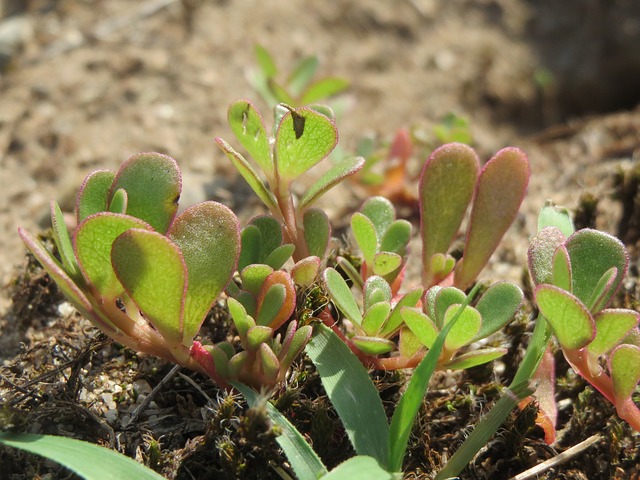
Purslane grows around patios and in empty garden beds. Herbal stores sell dried purslane for herbal remedies, but it’s likely growing free in your backyard. Purslane is a significant source of omega-3 fatty acids, more so than other leafy vegetables. It’s rich in vitamins A, C, and E, as well as magnesium, calcium, and potassium.
Purslane leaves are sour and salty so it can be an acquired taste. Try adding the leaves to soups and stews, or you can bread and fry the leaves for a tempura side dish.
You can use purslane for many medicinal purposes, such as:
- Insect Bites
- Bee stings
- Skin sores
- Diarrhea
- Hemorrhoids
Watch out: Poisonous spurge can look similar to purslane. Be sure you’ve correctly identified your plant before consuming it.
6. Chickweed (Stellaria media)
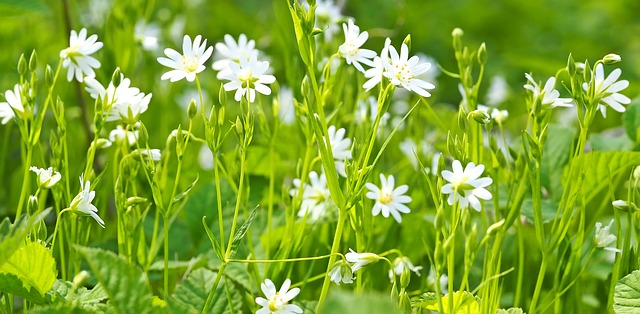
Chickweed is another well-known backyard medicinal weed that is a source of vitamins A, C, and D, as well as calcium, iron, and potassium. You can add chickweed to salads and sandwiches. It’s delicious fresh but also tasty in soups and stews.
Besides eating it, you can use chickweed as a topical treatment for minor cuts, burns, eczema, and rashes. You can also use chickweed for:
- Irritable bladder symptoms
- Cystitis bladder issues
- Constipation
- Coughs
- Hoarseness
- Kidney complaints
- Wounds
- Joint Pain
Watch out: Chickweed can resemble spurge and scarlet pimpernel. Both are poisonous.
7. Chicory (Cichorium intybus)
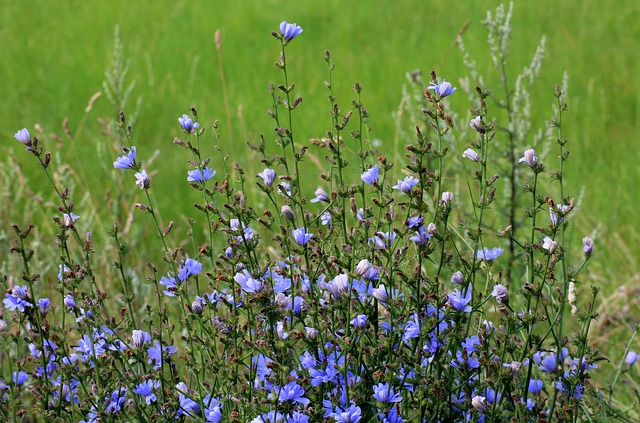
Chicory is known for its little, light blue flowers, growing along roadsides and other undesirable locations. You can boil the leaves and add them to meals, or try baking and grinding the roots as a coffee substitute.
This medicinal weed also can be used for various purposes, such as:
- Treating internal parasites
- An appetite stimulant
- A Diuretic
- For upset stomach
- Treating constipation
- Treating liver and bladder problems
Watch out: Be sure the chicory you’re harvesting hasn’t been sprayed with poison.
8. Daisies

Do you have tiny daisies dotting your yard? The greens and petals of the daisies are edible and can be eaten raw or cooked, but some do find the flavor to be a bit bitter.
For years, daisies have been brewed into a tea and used as traditional medicine for gastrointestinal and respiratory tract disorders. Daisies also have anti-inflammatory properties.
9. Curly Dock (Rumex crispus)
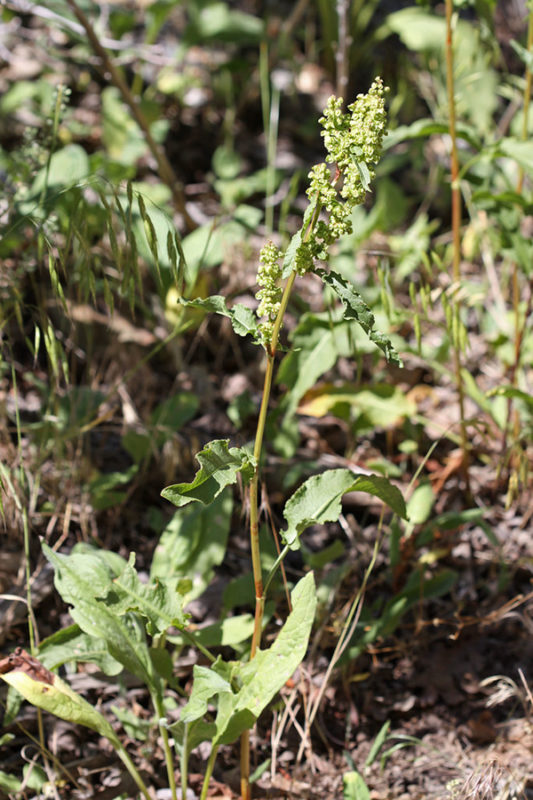
Curly dock is a hardy weed that most people have a hard time killing. It’s a widespread weed, so finding some shouldn’t be an issue. Curly dock leaves are high in beta-carotene and vitamin C, and the seeds are a source of calcium and fiber.
All parts of the curly dock are edible and can be eaten cooked or raw. Try adding the stems to salads or stir-fries. Medicinally, you can use curly dock as a:
- Laxative
- Astringent
- Way to promote wound healing
Watch out: Curly dock is poisonous for livestock in large enough amounts. It also contains calcium oxalate, which can be a problem for people with kidney stones.
10. Lamb’s Quarters (Chenopodium album)
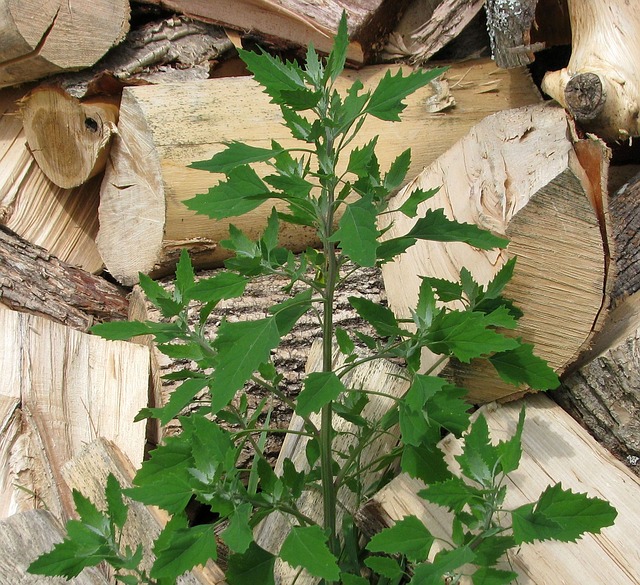
Another common weed that you can find in your backyard is lamb’s quarter, which multiplies throughout the summer, producing black seeds that are full of protein, similar to quinoa.
Lamb’s quarter is also a source of vitamin A, phosphorous, and potassium. So, it’s a great way to boost nutrients in your meals.
When using lamb’s quarter as a medicinal weed, make a tea to help with digestion issues and stomach aches.
Watch out: Young lamb’s quarter can look similar to nightshade, which is poisonous.
11. Common Mallow (Malva neglecta)
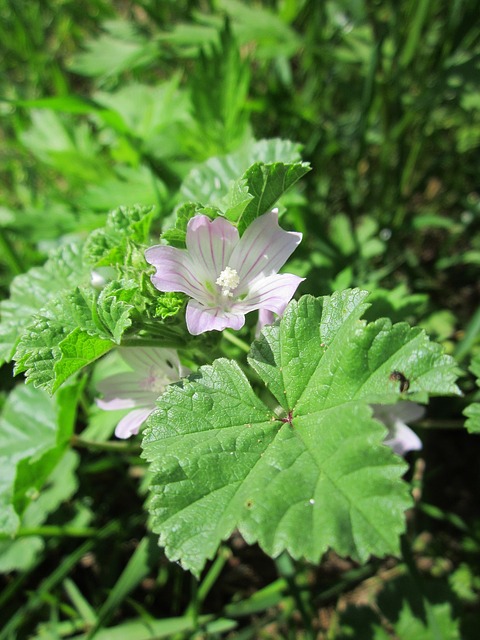
No, common mallow is not related to marshmallow, and it tastes nothing like the sweet treat. You can make a tea from the common mallow root, and it turns into a thick mixture, perfect for digestive and genitourinary tract issues.
You can eat the leaves of the common mallow weed, but most people find that the leaves are bitter unless you eat them young. Try cooking and eating them in place of other greens, and don’t forget the seed pods. Those pods contain an impressive 21% protein.
Mallow can be used for:
- Calming irritated throats
- Cough
- Stomach complaints
- Treating wounds
Watch out: Mallow grows pretty much everywhere, but if you’re harvesting from roadsides, be aware that plants might have been sprayed with pesticides or herbicides.
12. Red Clover (Trifolium pratense)
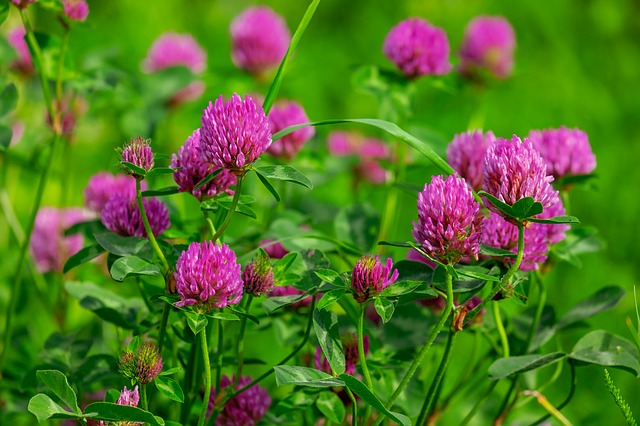
These pink-red flowers attract bees to your garden. They’re a source of food for bees and other insects, which are all good reasons to leave red clover in your yard. They’re just what the bees and your garden needs.
Red clover also has a long history as a useful medicinal weed. It’s known for its anti-inflammatory properties and a folk remedy for cancer. Of course, the American Cancer Society acknowledges that there is no real evidence to back up this claim. Instead, we do know that red clover is a source of calcium, magnesium, phosphorus, potassium, and vitamin C.
Ailments that can be treated by red clover include:
- Coughs
- Bronchitis
- Exhaustion
- Hormonal imbalances
- Anxiety
- Muscle spasms
Watch out: Red clover looks like crown vetch, which is poisonous to humans and horses.
13. Violets (Viola sororia)
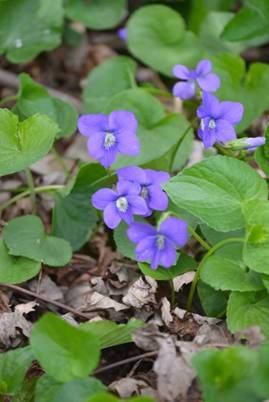
In spring, your yard is often covered in these purple flowers in mass quantities. Aside from being beautiful, violets are known for being versatile, and you can use them to make violet jelly and vinegar or as a medicinal treatment. Not bad for a little weed!
Violets are a mild-tasting weed with leaves and stems that can be eaten raw or cooked. You can dry the leaves to create a delicious violet tea.
Violets treat:
- Congestion
- Nervous issues
- Urinary problems
- Digestion issues
- Insomnia
Watch out: Violets have laxative qualities, so be careful. Don’t drink too much violet tea!
14. Wild Garlic (Allium ursinum)
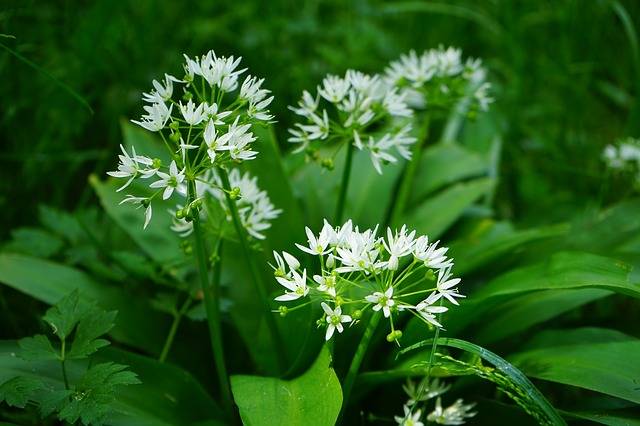
Perhaps you’ve stumbled across wild garlic in the field. It has white flowers and thin shoots, and it’s one of the most useful culinary and medicinal weeds out there. Wild garlic can be used in homemade pesto, as a replacement for chives or green onion, and added to salads and soups.
Wild garlic has some of the same properties as the regular garlic that we purchase in the store. It has antibacterial, antibiotic, antiseptic, and antifungal properties. There’s some evidence that it can even lower blood pressure as well as:
- Clear congested chest
- Reduce cholesterol
- Ease nausea
- A poultice on injuries
Watch out: Wild garlic looks like lily of the valley and autumn crocus, both of which are poisonous.
15. Mullein (Verbascum)
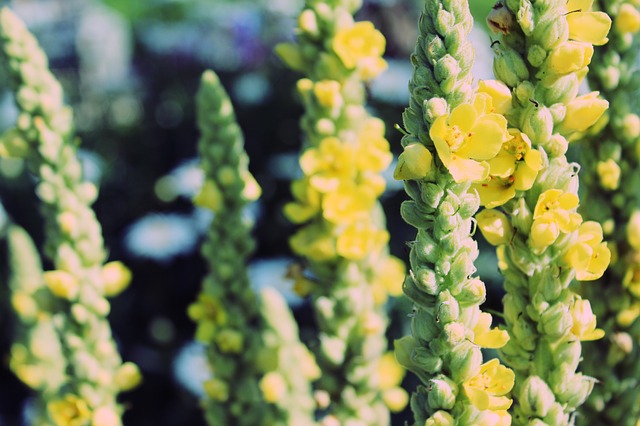
Many people grow mullein in their herbal garden for its medicinal purposes, but it also grows wild in some areas. It’s a hard weed to miss because it can grow up to eight feet tall with a distinct floral spear. The leaves are fuzzy, and it tends to show up in vacant lots, fields, and unkempt yards.
Infused mullein oil has been used as a treatment for ear infections. Mullein leaves can be used as a treatment for:
- Cough
- Congestion
- Asthma
- Cold
Foraging and Using Medicinal Weeds
When you start to forage medicinal weeds, it’s best if you learn how to identify these plants before you use them as an herbal remedy or in dishes. Some weeds have look-alikes that are similar but don’t offer nearly the same benefits or could even be poisonous. Also, never forage from an area that might have been sprayed with chemical weed killer. You don’t want to ingest poison.
It’s also worth noting that not all weeds have been thoroughly tested for their medicinal properties, so do your research before trusting your health to something you’ve plucked out of your garden.

